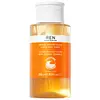What's inside
What's inside
 Key Ingredients
Key Ingredients

 Benefits
Benefits

 Concerns
Concerns

 Ingredients Side-by-side
Ingredients Side-by-side

Simmondsia Chinensis Seed Oil
EmollientCaprylic/Capric Triglyceride
MaskingOryza Sativa Bran Oil
EmollientOryza Sativa Germ Oil
EmollientCamellia Oleifera Seed Oil
Skin ConditioningGlycine Soja Oil
EmollientMacadamia Ternifolia Seed Oil
EmollientRosa Canina Fruit Oil
EmollientXimenia Americana Seed Oil
EmollientParfum
MaskingGlycine Soja Lipids
Skin ConditioningOryzanol
Skin ConditioningHippophae Rhamnoides Oil
EmollientVaccinium Macrocarpon Seed Oil
Skin ConditioningSafflower Oil/Palm Oil Aminopropanediol Esters
Skin ConditioningTocopherol
AntioxidantCymbopogon Martini Oil
MaskingPelargonium Graveolens Flower Oil
MaskingRosa Damascena Flower Oil
MaskingHelianthus Annuus Seed Oil
EmollientRosmarinus Officinalis Leaf Extract
AntimicrobialBenzyl Benzoate
AntimicrobialCitral
PerfumingCitronellol
PerfumingEugenol
PerfumingGeraniol
PerfumingSimmondsia Chinensis Seed Oil, Caprylic/Capric Triglyceride, Oryza Sativa Bran Oil, Oryza Sativa Germ Oil, Camellia Oleifera Seed Oil, Glycine Soja Oil, Macadamia Ternifolia Seed Oil, Rosa Canina Fruit Oil, Ximenia Americana Seed Oil, Parfum, Glycine Soja Lipids, Oryzanol, Hippophae Rhamnoides Oil, Vaccinium Macrocarpon Seed Oil, Safflower Oil/Palm Oil Aminopropanediol Esters, Tocopherol, Cymbopogon Martini Oil, Pelargonium Graveolens Flower Oil, Rosa Damascena Flower Oil, Helianthus Annuus Seed Oil, Rosmarinus Officinalis Leaf Extract, Benzyl Benzoate, Citral, Citronellol, Eugenol, Geraniol
Water
Skin ConditioningSodium Lactate
BufferingLactic Acid
BufferingHeptyl Glucoside
Potassium Azeloyl Diglycinate
Skin ConditioningTriethyl Citrate
MaskingGlyceryl Caprylate
EmollientSalix Nigra Bark Extract
Skin ProtectingBenzoic Acid
MaskingCitrus Nobilis Peel Oil
MaskingCitrus Aurantium Dulcis Flower Oil
AstringentCitrus Grandis Peel Oil
MaskingCitrus Tangerina Peel Oil
MaskingHeptanol
PerfumingParfum
MaskingLimonene
PerfumingWater, Sodium Lactate, Lactic Acid, Heptyl Glucoside, Potassium Azeloyl Diglycinate, Triethyl Citrate, Glyceryl Caprylate, Salix Nigra Bark Extract, Benzoic Acid, Citrus Nobilis Peel Oil, Citrus Aurantium Dulcis Flower Oil, Citrus Grandis Peel Oil, Citrus Tangerina Peel Oil, Heptanol, Parfum, Limonene
 Reviews
Reviews

Alternatives
Ingredients Explained
These ingredients are found in both products.
Ingredients higher up in an ingredient list are typically present in a larger amount.
Parfum is a catch-all term for an ingredient or more that is used to give a scent to products.
Also called "fragrance", this ingredient can be a blend of hundreds of chemicals or plant oils. This means every product with "fragrance" or "parfum" in the ingredients list is a different mixture.
For instance, Habanolide is a proprietary trade name for a specific aroma chemical. When used as a fragrance ingredient in cosmetics, most aroma chemicals fall under the broad labeling category of “FRAGRANCE” or “PARFUM” according to EU and US regulations.
The term 'parfum' or 'fragrance' is not regulated in many countries. In many cases, it is up to the brand to define this term.
For instance, many brands choose to label themselves as "fragrance-free" because they are not using synthetic fragrances. However, their products may still contain ingredients such as essential oils that are considered a fragrance by INCI standards.
One example is Calendula flower extract. Calendula is an essential oil that still imparts a scent or 'fragrance'.
Depending on the blend, the ingredients in the mixture can cause allergies and sensitivities on the skin. Some ingredients that are known EU allergens include linalool and citronellol.
Parfum can also be used to mask or cover an unpleasant scent.
The bottom line is: not all fragrances/parfum/ingredients are created equally. If you are worried about fragrances, we recommend taking a closer look at an ingredient. And of course, we always recommend speaking with a professional.
Learn more about Parfum